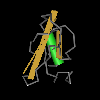?
 
Kunitz/Bovine pancreatic trypsin inhibitor (BPTI) domain This family contains the Kunitz domain which is a common structural fold found in a family of reversible serine protease inhibitors. This domain is thought to have evolved over 500 million years and is ubiquitous in all kingdoms of life and has been incorporated into many different genes. In general, each domain is encoded by a single exon. Some genes encode proteins with a single Kunitz domain, e.g. bovine pancreatic trypsin inhibitor (BPTI), trophoblast Kunitz domain protein (TKDP), amyloid beta-protein precursor (ABPP), as well as Kunitz-type venom peptides such as dendrotoxin. Genes that encode multiple Kunitz domains include hepatocyte growth factor activator inhibitors HAI1 and HAI2 (two domains), tissue factor pathway inhibitor TFPI1 and TFPI2 (three domains) and Caenorhabditis elegans papilin (eleven domains). In addition, the Kunitz domain has been integrated into multi-domain proteins, e.g. the collagen alpha3(VI), alpha1(VII) and alpha1(XXVIII) chains, WFIKKN1 (containing WAP, Follistatin/Kazal, Immunoglobulin, two Kunitz and NTR domains) and papilin. Furthermore, each domain within a multi-Kunitz domain protein may exhibit different protease activity, such as for the three tandemly repeated domains within both tissue factor pathway inhibitors 1 and 2. The Kunitz domain is a representative of alpha/beta proteins with irregular secondary structure stabilized by three disulfide bonds and presenting three peptide loops that can be varied without introducing much destabilization to the scaffold. Protease inhibitors meet the scaffold criteria in that they are small, stable and capable of evolving the binding activity of exposed peptide loops through targeted randomization to construct combinatorial libraries. Kunitz domain-based scaffolds have been successfully utilized to construct and select a library of protease inhibitors with the potential for therapeutic application. |
